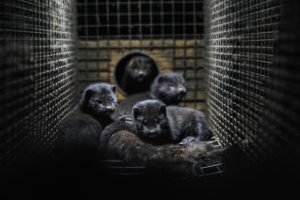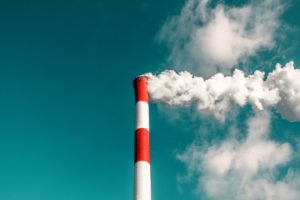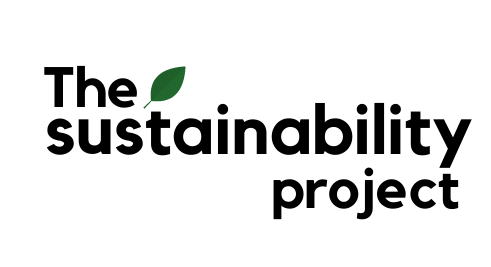If you think that your high-quality falsies and eyelash extensions are made of plastic fibers, guess what? It actually isn’t!
Did you know, your falsies and eyelash extensions are made from the fur of an adorable mammal called mink? And no, they are not by-products nor are they cruelty-free. In fact, more than 50 million minks are bred worldwide every year mostly for their fur.
So what exactly is mink fur? Why is it highly raved in the fur industry? What else is it commonly used for? And most importantly, how can we individuals help to bring down the numbers?
In this article, we answer these questions and uncover the hidden animal & environmental costs in our falsies and eyelash extensions.
Minks and its Cosmetics Uses
If you didn’t know, mink fur is the highest-selling fur worldwide at 80 million pelts in 2014. Branded as the Great Fur, mink fur is lightweight, naturally soft and fluffy, ultra-fine. This means mink fur has similar qualities to natural human lashes. But most importantly to the lash industry, it means that mink fur makes the most natural-looking, voluminous, durable lashes while feeling like almost nothing when worn near the eyes.
In case you’re thinking: How does this affect me? I don’t wear eyelash extensions nor fake eyelashes. Fur farms don’t just produce mink fur for fake eyelashes and eyelash extensions. As a matter of fact, mink fur is also a top favourite in the fashion and beauty industry. This implies that the expensive fur coats in your wardrobe and that stash of makeup brushes on your dressing table are too, possibly made from mink fur.
 Credits to: Human Society International
Credits to: Human Society International
Other than mink fur, do you know mink oil is also a recognized ingredient in the skincare & beauty industry?
Yes, our skincare and personal care products don’t steer clear of minks either. In reality, many beauty products often contain mink oil since it has similar properties to human sebum – our natural oil secretion.
Your shampoos, hair sprays, conditioners, lipsticks, cleansers, and facial moisturizers. They all contain mink oil because of their absorbent and non-pore clogging properties.
And lastly, the minks’ remaining carcasses get composted to produce fertilizers.
The facts are eye-opening, aren’t they? But the question that constantly roamed in my head was: If mink fur is no longer in trend one day, would minks still be killed for other commercial or money-making purposes?
The Unfashionable Truth Behind Fur-Farming and Fur Trade: Animal Cruelty
Take out your boxes of falsies and check for the materials involved. Chances are if animal fur is listed, it’s never cruelty-free. That “ethically-sourced”, “free-range” or “vegan” label. They will not be true. Truth is there are no specific laws that govern the cruelty-free labelling for products, which means companies are free to label however they wish. If you’re wondering how to differentiate trustable and non-trustable cruelty logos, keep reading the article!
For now, let’s look into the living conditions in mink fur farms.
 Credits to: Green Matters
Credits to: Green Matters
Inside the Lives of Farmed Minks
Can you imagine yourself permanently housed in small, confined wire cages? That’s exactly what minks in fur farms go through in their lifetime. These habitually active animals, recklessly bred, spent their entire lifetime forced in captivity in overcrowding, depressing, tiny, bare, and filthy wire-floored cages with their waste piled up beside them. And the piled-up excrement doesn’t just invite diseases and parasites, but the faecal stench also triggers social stress to minks due to their acute sense of smell.
They are fed unwanted meat that is unsafe for human consumption, they drink water from a nipple system that risks contamination if not regularly cleaned. They cope with freezing cold in the winter and scorching heat in the summer confined inside tiny battery cages, and sometimes they die from heat or cold stress.

Not just that, female minks used for breeding are only kept 4 -5 years before they are killed. These minks are bred once a year and while they have their babies with them for the first few weeks, the mink kits will eventually be killed and separated from their mothers once they are about six months. And I’m sure we can all agree that all mothers are protective of their young, let alone minks which are solitary and territorial animals that can occupy up to 2,500 acres of wetland habitat in the wild and turn aggressive once threatened.
Psychological Torment on Farmed Minks
Living in such deplorable conditions, it is no wonder that minks suffer severe distress and fear. Anxious and anguished, they succumb to self-mutilation and sometimes cannibalism as a result. Eating their young, repetitively pacing and circling, chewing their fur, biting their tails, and more. These are common yet abnormal psychotic behaviours that animals in captivity, not just minks, tend to exhibit under major distress. Additionally, these psychotic behaviors can possibly cause infections, mouth or body deformities such as missing limbs, bent feet, and more.
Not to mention that despite generations of being bred for fur, zoologists at Oxford University found that minks still have not been domesticated.
Cruel, Painful Slaughtering Methods in Mink Fur Farms
As you can tell, fur-farming processes are designed to maximize profits & minimize costs, and very often, at the expense of the animals. Minks bred for fur often experienced short and painful lives in fur farms, without a day in their natural habitats.
And what’s worse is that because minimal federal slaughter law protects animal welfare in mink fur farms, merciless slaughter methods are inevitably used to keep mink pelts intact and preserve the fur quality.
 Credits to: Financial Times
Credits to: Financial Times
1. Chemical Gas Suffocation
Small animals are shoved into pitch-dark gas chambers that are connected to an engine exhaust pipe, where they are either poisoned with carbon dioxide, carbon monoxide, or nitrogen.
While 100% of carbon dioxide induces immediate unconsciousness, workers often use lesser concentrations (70%) of carbon dioxide to reduce production costs. In other words, these poor animals are forced into a slow (15 minutes) and painful death.
2. Anal and Oral Electrocution
A metal clamp is forced into the animals’ mouth and a metal rod in the anus before the electrocution happens. This sends a high-voltage electrical current down the animals’ body, causing the animal to suffer a cardiac arrest while still conscious. While New York has banned this slaughter practice in 2008, this is still legal in other countries.
3. Neck-Breaking or Skinned-Alive
While it is unknown if any prior methods are used to put the animal to sleep, the workers do not check the unconsciousness of animals before breaking their necks or skinning them.
In this unregulated fur industry, nothing is transparent. Convenience and profit are always above animal ethics. In other words, it is possible for even more appalling slaughter methods to be hidden under the rug. As an animal lover myself, this is just unbearable to imagine. It’s sad to see that wild animals are now possessively considered as pure money-making tools.
In addition, some fur farms don’t just raise minks. Animals like rabbits, foxes, chinchillas are also raised for other commercial purposes. If you’d like to find out more, here’s an article for you.
The Environmental Costs in Mink Fur-Farming: From Feed to Fur
Let’s take offal (minks’ primary resource of feed) as an example.
With an estimated ratio of 1kg of fur to 550 kg of feed, can you imagine the amount of feed needed for the fur industry worldwide?
Although offal is predominantly by-products that can reduce meat emissions, large quantities of feed still account for a considerable amount of environmental footprint. For instance, the manual or machinery effort to extract the offal meat, transportation energy to send the offal over to farms, the storage space, and more…
Not to forget drinking water for minks, the materials and effort needed to manufacture and install the nipple auto-drinking system, the animal cage, the big space for farm animals… And of course, the energy and gas emissions from electrocuting and gassing the animals.

On average, producing 1 kg of mink fur equates to 110 kg of carbon dioxide gases released into the atmosphere. Mink fur is simply inefficiently produced, considering the resources that went into it. Comparing to other fabrics such as wool, cotton, and polyester, mink fur is still the biggest contributor to climate change. This means that natural isn’t always the most environmental-friendly.
And the point is, it is near impossible to calculate the exact environmental impact due to the lack of regulations. Nobody knows the specific and exact activities performed in each level of the supply chain before the fur turns into fur coats and fake eyelashes.
A Mutant Coronavirus Strain in Danish Mink Fur Farms
Covid-19 has crippled many economies, took over 2 million lives, and struck terror into countries around the world. However, did you know that a nationwide cull in Denmark has killed almost every mink in Denmark and wiped out the world’s largest mink fur industry to curb a mink-associated coronavirus strain?
That is almost 17 million minks perished. Although Denmark researchers have reported that the mutations aren’t dangerous and Denmark’s Prime Minister Mette Frederiksen has admitted that it was a hasty decision, it is no doubt that the tremendous impact on the mink population has already been made.
Not to mention that the mink cull has also turned the spotlight of the fur trade on other animals like foxes and chinchillas. Sadly, the fall of the mink fur industry may have rose the demands for the fur of other animals.
With that, here are some thought-provoking questions for you to ponder:
- Is it worthwhile to exchange the lives of 17 million minks for the fall of the mink fur industry in Denmark?
- Do you think this marks the complete end mink fur industry in Denmark, or would it revive?
- If only there were no captive or farmed minks in Denmark, would they have avoided the cull?
Saving Minks: How Can We Help?
While more and more countries like the United Kingdom are banning mink fur farming, it is still a living trade. 50% of mink fur farms are in Europe while the rest are spread around North America, Argentina, China, Russia, Norway, and more.
In hindsight, I am still fearful that even if fur-farming is globally banned one day, the fur industry might be shifted underground like how the mica industry was.
Read more: Mining Mica – The True Costs of Beauty Products.
Considering how large the fur industry is, the question now is: What can one individual do to help the minks?
 Credits to: Financial Times
Credits to: Financial Times
1. Support Efforts of Organisation Tackling The Fur Industry
With the prominence of animal cruelty in the fur industry, many organizations have stepped up to advocate for animal rights.
This includes:
People for the Ethical Treatment of Animals (PETA): An international non-profit organization in Virginia that work through cruelty investigations and research database to educate global public and policymakers about animal abuse.
Fur Free Alliance: An International coalition of animal protection organizations working together to encourage the global adoption of a fur-free policy in businesses, mainly through their Fur Free Retailer program.
Humane Society International: An international organization that advocates the human-animal bond through animal rescues, promoting animal-free testing, wildlife protection, and improving animal welfare in farms.
2. Opt for Cruelty-Free Mascaras and Fake Eyelashes
There is always a way to glam up yourself sustainably. By opting for cruelty-free mascaras, you are supporting companies to move away from testing their products and the ingredients on animals.
If you are looking at fake eyelashes, you can always start building your zero-waste makeup routine by switching to faux fur lashes, which are equally durable and natural as mink eyelashes!
Faux fur is a synthetic fabric made from blends of acrylic, nylon, or polyesters fibers, and it can be infused with other materials like wool or cotton through various manufacturing techniques. While natural fur is biodegradable and compostable, studies have shown that a mink fur coat has minimally 5 times more environmental impact compared to a faux fur coat.
Hence, if you are a beginner in cruelty-free or zero-waste makeup, faux fur is a great alternative!
 Credits to: Pop Sugar
Credits to: Pop Sugar
3. Understanding Cruelty-Free Logos
There are three official organizations that certify brands as cruelty-free – Leaping Bunny, PETA, and Choose Cruelty-Free. They go through various standards and authorities before certifying brands, as shown in the picture below.
Having said that, all other bunny logos are unofficial and unregulated. This implies a possibility that the brands’ products or ingredients were tested on animals before, sometimes without the brands’ knowledge. However, as conscious consumers, we should always look beyond the bunny labels and ask ourselves these three key questions:
- Are animals involved in the making or testing of the product?
- What are its ingredients’ origins?
- If the brand doesn’t conduct animal testing, what are testing alternatives adopted?
You may not know, but as consumers, we hold so much power in determining animals’ lives. Every single purchase made doesn’t just mean supporting the product, but also every ingredient and process involved in the making.
Now that you have finished reading the article, I hope it has been helpful and useful knowledge. If you found yourself owning any fur products, please don’t ever condemn yourself! Going forward, explore how we can make the world a better place for our little furry friends!
And for those who have been religiously avoiding fur products, the animals and the environment thank you! Please don’t be shy to share your sustainable tips with everyone else! 😊



Just desire to say your article is as astonishing. The clarity to your submit is just great and that i could assume you’re an expert on this subject.
Well together with your permission let me to grab your feed to stay updated with forthcoming
post. Thanks one million and please continue the gratifying work.
Glad you enjoyed reading it 🙂